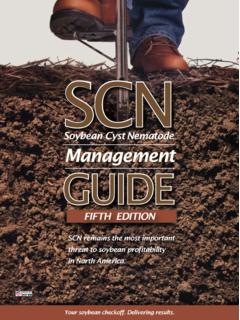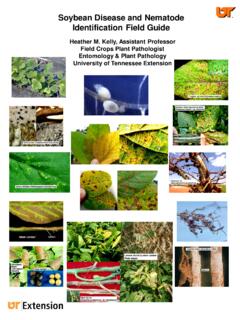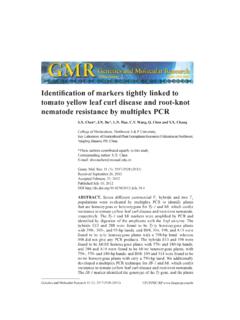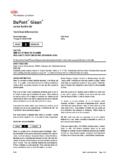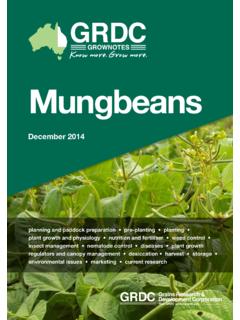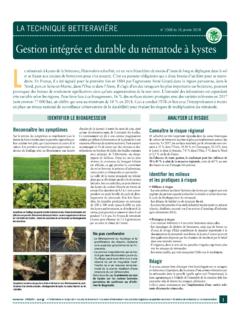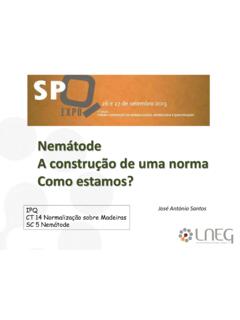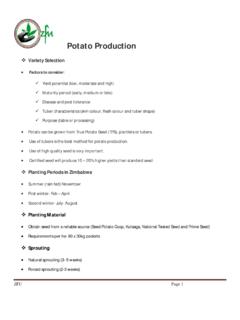Transcription of Yearly Calendar for St. Augustinegrass Care and …
1 Fact Sheet ENH-731995 Yearly Calendar for St. Augustinegrass care and Culture1L. B. McCarty and John L. Cisar2St. Augustinegrass is a fast-growing, warm-seasonturfgrass used extensively in Florida. It grows well onmost well drained soils. For optimum quality,adequate irrigation and fertilization are required. is tolerant to saline irrigation andbrackish water, and is the best shade tolerant grasssuitable for Florida. Since most St. Augustinegrasscultivars are quite sensitive to freezing temperatures,other turfgrasses may be more appropriate in thenorthern and panhandle areas of Florida. Also, is coarse (wide) in leaf texture and haspoor wear tolerance, which may be undesirable forsome of St. Augustinegrass differ in theirresistance to plant pests. Only the cultivars Floralawnand Floratam are tolerant to the southern chinch bug,a common turfgrass insect. Another insect, sodwebworm, and the fungal diseases brown patch andgrey leaf spot can also cause discussed in this section, proper lawnmanagement practices are the best means of avoidingplant pest problems and obtaining high qualityturfgrass.
2 If problems continue, contact your localCooperative Extension Service office for further information on available cultivars andestablishment practices, refer to lawn establishmentand maintenance sections. Local growing conditionsand resources available may require growers toslightly deviate from these MAINTENANCEThe level of lawn maintenance is dependent onturfgrass quality desired, time, and money available(Table 1). These factors will regulate the amount offertilizer and pesticides applied each year. Personsrequiring minimal maintenance for their lawns shouldhave a low fertility program and apply pesticides onlyon a curative basis only. This consists of two fertilizerapplications per year at the rate of 1 pound ofnitrogen per 1000 square feet per application ( , pounds 16 4 8 = 1 pound nitrogen, poundP2O5, and pound K2O per 1000 square feet). Thefirst application should follow the onset of springgreen-up, and the last should be timed for latesummer in north Florida and early fall in southFlorida.
3 A high-maintenance lawn in Florida wouldreceive 4 pounds of nitrogen per 1000 square feet peryear applied in 1-pound increments during March,May, July, and September. In south Florida, anadditional application of fertilizer may be required inearly winter due to the extended growing season andsandy soils. Although nitrogen is the element mostcommonly applied to turfgrass, other essentialelements, plus micronutrients, should be part of afertilizer maintenance program. For all maintenancelevels, a minimum of two treatments of a completefertilizer such as 16 4 8 or 12 4 8 should be madeper year in order to supply the other essentialelements of phosphorus and potassium. Completefertilizers (N P K) containing micronutrients such as1. This document is Fact Sheet ENH-73, a series of the Environmental Horticulture Department, Florida Cooperative Extension Service, Instituteof Food and Agricultural Sciences, University of Florida.
4 This information is included in the Florida Lawn Handbook, SP-45. For a copy ofthis handbook, request information on its purchase at your county extension office. First published: May 1991. Revised: January L. B. McCarty, associate professor, Commercial Turf Specialist, Environmental Horticulture Department, Gainesville; John L. Cisar, associateprofessor, Turf Specialist, Ft. Lauderdale Research and Education Center, Cooperative Extension Service, Institute of Food and AgriculturalSciences, University of Florida, Gainesville FL Institute of Food and Agricultural Sciences is an equal opportunity/affirmative action employer authorized to provide research, educationalinformation and other services only to individuals and institutions that function without regard to race, color, sex, age, handicap, or nationalorigin. For information on obtaining other extension publications, contact your county Cooperative Extension Service Cooperative Extension Service / Institute of Food and Agricultural Sciences / University of Florida / Christine Taylor Stephens, DeanYearly Calendar for St.
5 Augustinegrass care and CulturePage 2manganese (Mn), iron (Fe), sulfur (S), magnesium(Mg) and boron (B) should also be considered,especially if micronutrient deficiencies are expectedfor the lawn site. Other applications can be just anitrogen fertilizer source or fertilizer with nitrogenand potassium ( , 15 0 14).Additionalapplications may be required to encourage turfrecovery from environmental stress or pest damage orto encourage rapid coverage for a newly sprigged orplugged - MAYM owingProper mowing practices are essential formaintaining a quality lawn. Mow the lawn at 3 inchesas needed on low-maintenance lawns or 2 inches onhigher-maintenance lawns. Mowing at a lower heightwill encourage shallow rooting, which is less tolerantto drought and nematode pressure. Remove no morethan the height of the leaf blade with any mowing( , for a lawn to be maintained at 3 inches inheight, mow when the turf reaches 4 to 4 inches).
6 Rotary mowers are typically used to maintain homelawns. Over time, impact of the rotary blade with will dull the mower blades. Mowingwith dull blades will shred leaf blades, extend therecovery period of the grass, and lower the aestheticquality of the lawn. Use only a sharp, balancedmower blade and return clippings on the lawn unlessthe amount is excessive ( , clumping occurs). Ifclippings are excessive, allow them to dry in the sunand then scatter them by remowing, blowing, weeks following spring regrowth(approximately March in north Florida, February insouth Florida), apply a complete fertilizer such as16 4 8 at the rate of 1 pound nitrogen per 1000square feet ( , pounds 16 4 8 per 1000 squarefeet). The numbers refer to percent nitrogen,phosphorus (P2O5), and potassium (K2O), respectively,in the bag. A complete fertilizer contains all threemajor nutrients. For example, a 50-pound bag of16 4 8 contains 16% nitrogen or 8 pounds totalnitrogen.
7 For a 1-pound nitrogen per 1000 squarefoot rate, this bag will cover 8000 square feet. Forhigher-maintained lawns, apply 1 pound nitrogen per1000 square feet again in May. On high pH (> )soils or where high pH water is applied, yellowappearance may be an indication of iron ormanganese deficiency. For iron deficiency, sprayferrous sulfate (2 ounces in 3 to 5 gallons of waterper 1000 square feet) or a chelated iron source (referto the label for rates), to temporarily enhance applications every 6 weeks will help maintaingreen color and, unlike nitrogen, will not promoteexcessive topgrowth. On high pH soils (> ) orwhere high pH (> ) water is applied, manganesedeficiency may also become evident. Lower the soilpH by applying 15 pounds elemental sulfur per 1000square feet prior to grass establishment. Once thegrass is established, up to 5 pounds of elementalsulfur may be added per 1000 square feet, if it isimmediately irrigated in to prevent burn.
8 Usingammonium nitrate or sulfate as a fertilizer source willalso help to temporarily reduce soil pH. Applymanganese as a fertilizer with micronutrients or asstraight manganese sulfate (MnSO4) bimonthly at per 1000 square feet (18 pounds per acre) torelieve deficiency symptoms if present. Submit a soilsample Yearly to your local county CooperativeExtension Service office to determine the soil pH,nutrient levels present, and if any deficiencies , fall through spring is the driest periodof the year. Therefore, irrigation is required toreplace water lost via evapotranspiration. For waterconservation, irrigate to prevent drought stress on anas-needed basis. Irrigate when the turf begins to wilt,turns blue-gray in color, and/or recovery from foot ortire tracks is slow. Apply enough water to rewet thesoil rootzone and then wait until the turf shows signsof drought ( , wilting) again before the nextirrigation (usually every 7 to 14 days in winter, 3 to 4days in April-May, depending on soil type andmaintenance practices).
9 For most Florida soils, nomore than inch of water is necessary for eachirrigation period to rewet the top 8 to 12 inches ofthe root zone. To determine the amount of waterbeing applied, place several coffee cans around yourirrigation system. Turn on the system for a specifictime period. Measure the depth of water in each can,and take an average. The time required to achieve anaverage of inch depth of water is the time periodone should use for each irrigation period. The lengthof the irrigation period to apply this inch can stayconstant year round; only thefrequencybetweenirrigations should change. Therefore, irrigationprograms set by automatic timers do not need tooperate on a daily schedule. They need only tooperate after the turf begins to show signs of droughtand then be programmed to apply an average of Yearly Calendar for St. Augustinegrass care and CulturePage 3inch of water. Overwatering encourages nutrientleaching, increased pest problems, shallow rooting,and, of course, water waste.
10 For further informationrefer to the chapter on "How to Calibrate YourSprinkler System" in this ControlThe best approach to weed control is a healthy,vigorous turf. Proper mowing height, fertilization,and watering must be followed to encourage acompetitive lawn grass. If a herbicide is needed,apply preemergence herbicides ( , pendimethalin,benefin, bensulide, atrazine, or others) to controlcrabgrass if it was present in previous years. Timingis critical for successful control. A general rule ofthumb for application is Feb. 1 in south Florida, in central Florida, and March 1 in north : Preemergence herbicides will not control weedswhich are actively postemergenceherbicides ( , atrazine) in May as needed forcontrol of summer annual and perennial broadleafweeds such as knotweed, spurge, lespedeza, etc. Tocontrol emerged summer annual grass weeds such ascrabgrass and goosegrass, the herbicide asulam maybe used.

